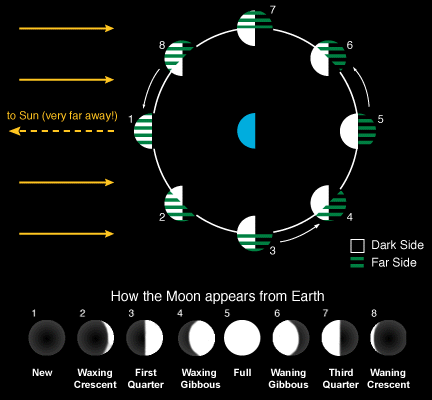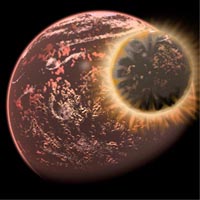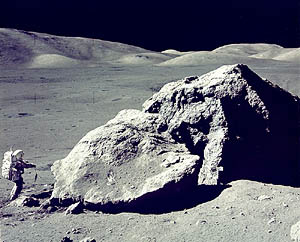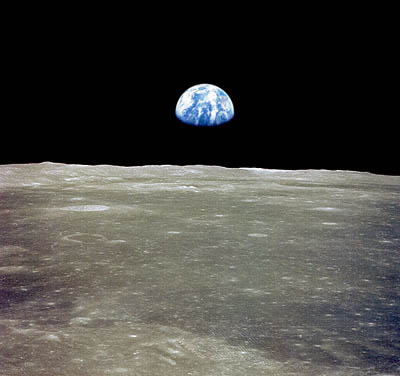Lunar Love
The Moon
Guiding Light
Our closest neighbor in space, the Moon has always held a strong fascination. In ancient times, the Moon was associated with fertility, intuition, and emotion. Its phases provided humankind with a calendar in the sky, and a guide for planting, holidays, and celebrations. The Moon's light was thought to be indispensable for abundant harvests, large flocks and herds. In the Renaissance and Reformation, people scheduled their marriages, journeys, business arrangements, and even their haircuts according to the phases of the Moon. The Moon was believed to govern the moisture in the body and brain, and in 1660 a British astrologer declared that children born at the full Moon would never be healthy and ran the risk of "lunacy". Folklore beliefs about the Moon persist to the present day.What do we know now? What is the Moon really like? Let's find out!
Our Nearest Neighbor in Space
| The average distance of the Moon from the Earth is about 385,000 km -- 240,000 miles, or about the total driving distance you could expect to get out of a really good car or truck over its lifetime. Our Moon travels around the Earth in an elliptical orbit which brings it as near as 363,300 km and takes it as far away as 405,500 km. The Moon's orbital period around the Earth is 27.322 days one lunar month. The Moon is locked in phase with the Earth ("synchronous rotation"), so its period of rotation around its own axis is also 27.322 days and it keeps the same face turned towards the Earth. You have to go there to see the other side, and so we had no idea what the far side looked like until the Soviet Luna 3 spacecraft orbited and returned pictures. The angular size of the Moon is about half a degree, which also happens to be the apparent size of the Sun. This lucky coincidence makes it possible to see total solar eclipses, where the Moon comes directly between the Sun and the Earth. |
 Reload the page to see the animation again. This animation was created by
António Cidadão.
Reload the page to see the animation again. This animation was created by
António Cidadão.
|
When we look at the surface of the Moon, we can clearly see the difference between the bright, rough, densely-cratered mountainous highlands and the darker, smoother plains known as maria (which is Latin for "seas"). The highlands were named after mountain chains on the Earth, although they were not formed by tectonic activity. The maria were given names like the Sea of Tranquility, the Sea of Clouds, and the Sea of Humors. However, the Moon has no atmosphere, and little to no water. Temperatures at its equator range from -185 degrees Celsius during its long nights to 215 degrees Celsius by day. The poles of the Moon are a more stable, but still rather chilly, -96 degrees Celsius. The "seas" are in fact plains composed of basalt. The lunar surface is covered by a fine-grained soil called "regolith" which results from the constant bombardment of the lunar rocks by small meteorites.
Throughout its history the Moon has been bombarded by these meteoroids, with sizes ranging from less than a centimeter to more than a kilometer. They account for the huge number of craters that cover the Moon's surface - perhaps 30,000 craters are visible from the Earth. Most of these, particularly the largest, were formed in an era of heavy bombardment about 4 billion years ago. The craters on the side of the Moon that face us tend to be named after well-known scientists such as Copernicus, Tycho (after Brahe), Bruno, Descartes, and Ptolomaeus. Features on the other side have more modern and more Russian names: Tsiolkovsky, Gagarin, Korolev, Apollo.
The diameter of the Moon is 3,500 km -- "seven thousand miles around." (The Earth, by comparison, is about 24,000 miles in circumference.) The Moon has about 1/81 the mass of the Earth, and is little over half as dense. The core of the moon holds only about two percent of the Moon's mass. By comparison, about one third of the Earth's mass lies in its core. The gravity on the surface of the Moon is one-sixth of that on Earth.
"Don't tell me that our love is just a phase."
During the course of the lunar month, the Moon shows us a different fraction of its illuminated face. The phases of the Moon depend upon the Moon's position relative to the Sun and the Earth.

In our schematic diagram, we show the phases of the Moon, along with their names. When the Moon is between the Sun and the Earth, the side of the Moon facing the Earth is dark. We call this a "new Moon". Soon we see a crescent Moon, as some of its sunlit side becomes visible to us. Seven days after new Moon, the Sun, Moon, and the Earth form a 90-degree angle, and so at "first quarter" the Moon appears to us to be half-sunlit and half in shadow. The Moon continues in its path around the Earth until "full Moon", when its surface is completely illuminated. At this point, the Moon, Earth, and Sun are again aligned but the Earth is now in between the other two celestial bodies.
It's all downhill from here. The Moon travels on around its orbit to "third quarter", when it is again half in sunlight and half dark. The Moon once again becomes a crescent just before "new Moon", when the cycle repeats. The time between successive new Moons is 29.5 days, a little different from its orbital period measured against the stars due to the distance moved by the Earth around the Sun during this time.
The Moon is said to be "waxing" when its illuminated face is growing, and "waning" in the second part of the cycle when the illuminated portion is decreasing.
In romance novels, and even in some science fiction novels, you may find that the author has the Moon rising at sunset for dramatic effect. Well, sometimes it does, and sometimes it doesn't; in reality, the various phases of the Moon rise and set at specific times of the night or day. The full Moon indeed rises shortly after sunset, but as it wanes, it rises later and later in the evening until at last quarter it rises at midnight. When the Moon is new it rises at dawn and sets with the Sun. At first quarter, the Moon rises at midday, and as it waxes it rises later in the afternoon until full Moon comes around again.
The Moon's gravitational pull has a big effect on the Earth's oceans. The familiar tides are caused by the gravitational attraction of the Moon. At any particular time there are two high tides occurring on the Earth; the direct tide, on the side of the Earth facing the Moon, and the indirect tide on the opposite side of the Earth. The average interval between high tides is around 12 hrs 25 minutes. Typically, in the open ocean, the difference in sea level between high and low tides is about 2 feet, but near the coasts it can be much greater. The Bay of Fundy in northeastern Canada is an extreme case; here, the tidal difference can be 40-50 feet.
The History of the Moon, Part I
Before the missions to the Moon, there were three competing ideas about how the Moon may have been formed.In the co-accretion model, the Moon formed around the same time as the Earth as they both coalesced separately. The major problem with this model is that it is difficult to explain why the Moon is so different from the Earth in density.
 In the fission model, the Moon split off from the Earth. As it
formed, the Earth had so much angular momentum after its iron core
was formed that it flung off a substantial chunk of material that
became the Moon. This explains the chemical differences, since
the fissioned material contains only elements found in the mantle
of the Earth. But: how did the Earth achieve such a high angular
momentum? And why, then, does the Moon orbit in a plane inclined
to the Earth's spin equator?
In the fission model, the Moon split off from the Earth. As it
formed, the Earth had so much angular momentum after its iron core
was formed that it flung off a substantial chunk of material that
became the Moon. This explains the chemical differences, since
the fissioned material contains only elements found in the mantle
of the Earth. But: how did the Earth achieve such a high angular
momentum? And why, then, does the Moon orbit in a plane inclined
to the Earth's spin equator?
In the capture model, the Moon formed in a separate area of the solar system and was later captured by the Earth's gravitational field. However, the mechanism for capturing such a large body in a closed orbit around the Earth is difficult to achieve.
As it turns out, none of these models match the geological evidence from the Moon rocks brought back from a variety of lunar sites by the Apollo astronauts. Now the front-runner is a variation on the fission model known as the impact theory (or less formally as the Big Splash). In this theory, the Earth was struck by an object perhaps a tenth as massive as the Earth, around 4.6 billion years ago. The shock of impact sent a molten ball of material from the Earth's mantle into space, which then cooled to become the Moon.
The Story in the Rocks
The oldest rocks brought back from the Moon were collected in the lunar highlands and are 4.4 billion years old. The rocks found in the blanket of ejected material near craters are 4.2 billion years old. Rocks near the maria are 3.9 billion years old, and the basalt of the maria itself is a little newer, 3.7 billion years. The youngest of the Moon rocks is 3.5 billion years old.From these ages and the rock types, we can figure out the geological history of the Moon. During the first 200 million years after its formation, its outermost lunar layers were molten. Soon they solidified into a crust, to form the rugged lunar highlands. The next 500 million years (4.4-3.9 billion years ago), the surface of the "new" moon was heavily bombarded by material left over from the Moon's formation. Some of these impacts carved out the giant impact basins, many hundreds of kilometers across, that still mark the Moon's surface. During this time, the interior heating caused by radioactive decay was greater than the heat radiated into space as the crust cooled, and as a result molten lava cracked through the crust at the impact points, spreading across the surface of the Moon to form the maria. By 3.5 billion years ago the main features of the Moon we see were already in place; since then some additional cratering has occurred, but no other significant volcanic eruptions.
Rock samples from the maria are dark, fine-grained, and definitely of volcanic origin. They are similar to basalts observed on the Earth, although they are relatively very rich in minerals and lack the water and other volatiles that Earth rocks contain. The older material from the highlands is richer in aluminum and shows signs of having been pulverized and re-fused; such rocks are known as breccias. The lunar soil is a fine-grained mixture the consistency of sand and gravel, made up of glass spheres from impact ejecta, dust, and ground-up breccia.
What's it like to walk on the moon? Let's find out from the first person to try it out: "The surface is fine and powdery. I can pick it up loosely with my toe. It does adhere in fine layers like powdered charcoal to the sole and side of my boots. I only go in a small fraction of an inch, maybe an eighth of an inch, but I can see the footprints of my boots... There seems to be no difficulty in moving around. It's even perhaps easier than the simulations. It has a stark beauty all its own. It's like much of the high desert of the United States. It's different but it's very pretty out here. Magnificent sight." Neil Armstrong, Apollo 11 (from the Technical Air-to-Ground voice transcriptions).
The History of the Moon, Part II
Aristarchus of Samos, a Greek philosopher who lived in the third century B.C., was the first to try to measure the distance to the Moon, using the geometry of the Earth-Moon-Sun triangle. His estimate wasn't particularly accurate. However, in the next century, Hipparchus used the Moon's parallax to measure the Earth- Moon distance and the diameter of the Moon to within a few percent. Not bad for over two millennia ago, and the measurements didn't get a lot better than this until radar was invented in the middle of the 20th century. Today, laser ranging techniques can measure the Moon's distance to within a few centimeters. The Moon is one of very few astronomical objects we can actually bounce a laser or a radio signal off, to directly deduce how far away it is.In 1610, Galileo studied the craters of the Moon through one of the first telescopes. He probably didn't imagine that in less than 400 years, people from Earth would walk there.
A variety of unmanned probes went first. In 1959 the Russian Luna satellites impacted the moon and photographed its far side, and in 1966 Luna 9 and Lunar 10 achieved soft lunar landing and lunar orbit. The US Project Ranger and Project Surveyor spacecraft landed on the Moon and returned thousands of pictures from lunar surface, and performed the first chemical analyses of lunar soil (Surveyor 5, in 1967). In 1966-7 the Lunar Orbiter series of five spacecraft were inserted into lunar orbit and photographed 95% of the surface as part of the search for potential Apollo landing sites.
Apollo 8 took humans out of Earth orbit for the first time. Over Christmas 1968, Borman, Lovell and Anders orbited the Moon ten times and took photos of the Earth rising over the lunar horizon.
 On July 20th 1969, astronauts Neil Armstrong and Buzz Aldrin landed
the lunar module of Apollo 11 on the Moon's surface and became the
first people to set foot on another place in our Solar System.
Neil called it "One small step for a man, a giant leap for
mankind." It was the triumphant climax of almost ten years of
dedicated effort by NASA to meet John F. Kennedy's challenge in
May 1961: "I believe this nation should commit itself, before this
decade is out, to landing a man on the Moon and returning him
safely to the Earth."
On July 20th 1969, astronauts Neil Armstrong and Buzz Aldrin landed
the lunar module of Apollo 11 on the Moon's surface and became the
first people to set foot on another place in our Solar System.
Neil called it "One small step for a man, a giant leap for
mankind." It was the triumphant climax of almost ten years of
dedicated effort by NASA to meet John F. Kennedy's challenge in
May 1961: "I believe this nation should commit itself, before this
decade is out, to landing a man on the Moon and returning him
safely to the Earth."
Charles Conrad and Alan Bean (Apollo 12) made a pinpoint landing on the Moon just 600 feet away from the unmanned Surveyor 3 probe. As the second crew to land, Conrad and Bean could afford to be more relaxed and lighthearted about their adventure than Armstrong and Aldrin, joking, laughing, humming and singing as they worked to set up a package of science experiments known as ALSEP. When they ran, jumping high in the weak gravity, Conrad described them as "giraffes running in slow motion." On their second moonwalk they visited the Surveyor 3 probe and explored the rim of the crater nearby.
Apollo 13 probably needs no introduction. As described in Jim Lovell's book "Lost Moon" and the Tom Hanks movie "Apollo 13", the third spaceship to the Moon suffered an explosion in an oxygen tank inside the Service Module. It took heroic efforts by the astronauts and the dedicated team at Mission Control to bring Jim Lovell, Jack Swigert, and Fred Haise safely back to Earth.
The third moon landing, Apollo 14, was the first dedicated entirely to scientific exploration of the Moon. Alan Shepard and Edgar Mitchell performed two moonwalks and collected nearly 100 pounds of moon rock. Also, Shepard hit a golf ball on the moon, using a makeshift club made from a six-iron head and the handle of a rock-collecting tool. The first tanked into a nearby crater. The second soared into the distance in the Moon's light gravity.
 The last three flights to the Moon used a beefed-up Lunar Module
which allowed astronauts to stay on the surface for several days,
and included geological field trips of 25-30 km using the Lunar
Rover, a battery-powered fat-tire four-wheel-drive dune buggy. The
astronauts used sophisticated instruments to measure lunar
gravity, magnetism, and seismic activity, as well as solar
radiation. They brought home 382 kg of lunar rock and lunar soil,
and proved themselves to be among the most skilled explorers in
history.
The last three flights to the Moon used a beefed-up Lunar Module
which allowed astronauts to stay on the surface for several days,
and included geological field trips of 25-30 km using the Lunar
Rover, a battery-powered fat-tire four-wheel-drive dune buggy. The
astronauts used sophisticated instruments to measure lunar
gravity, magnetism, and seismic activity, as well as solar
radiation. They brought home 382 kg of lunar rock and lunar soil,
and proved themselves to be among the most skilled explorers in
history.
David Scott (Apollo 15) dropped a feather and a hammer. They fell side by side and hit the dust at the same time. His experiment echoed one performed by Galileo, hundreds of years before, where the scientist dropped two different weights from the top of the Leaning Tower of Pisa, to prove that gravity acts equally on all objects regardless of their mass. John Young and Charlie Duke (Apollo 16) explored the Moon's central highlands. Gene Cernan and Harrison Schmidt (Apollo 17) were the last men to walk on the Moon, flying the Lunar Module into a narrow box canyon high in the Taurus Mountains for a stay that would last over three days. Schmidt was a geologist, the first professional scientist to go to the Moon.
In 1994 the Moon was extensively mapped by the Clementine spacecraft, which found tantalizing evidence that water ice might be present at the bottoms of deep craters at the Moon’s north and south poles. The Lunar Reconnaissance Orbiter, which has been surveying the Moon since 2009 and still continues to send back high quality data, has also provided supporting evidence for the presence of water on the Moon. In October 2020 it was announced that molecular water had been discovered on the Moon’s sunlit surface, likely protected from evaporation by being stored within glassy substances or sheltering within grains. The presence of water on the Moon is obviously an extremely exciting development, and may even one day help to support future human outposts on the Moon.
Why go back?
 The Apollo missions taught us a lot about the Moon
itself and about our ability to live, work, and explore in space.
But, to quote one of the Apollo astronauts: "To think that twelve
guys went there and we've figured it out, that's crazy." (John
Young, Apollo 16, from an interview given at the Johnson Space
Center in 1989.) The Moon remains an attractive target for
exploration, both because of its scientific interest and as a test
site for developing methods of exploring other planets in the
Solar System.
The Apollo missions taught us a lot about the Moon
itself and about our ability to live, work, and explore in space.
But, to quote one of the Apollo astronauts: "To think that twelve
guys went there and we've figured it out, that's crazy." (John
Young, Apollo 16, from an interview given at the Johnson Space
Center in 1989.) The Moon remains an attractive target for
exploration, both because of its scientific interest and as a test
site for developing methods of exploring other planets in the
Solar System.
Cheap energy is one good reason to make the trip. Solar power stations could be set up on the Moon and used to relay energy as microwaves to receiving stations on Earth. Although expensive to set up, such a system could power most of the Earth's energy requirements and turn a profit within ten years.
Also, helium-3 is plentiful on the Moon; it is one of many gases deposited by the solar wind. Fusion reactors using helium-3 would be much cleaner, safe, and more efficient than their counterparts on Earth. Mining helium-3 would be straightforward matter of collecting dust, heating it, and saving the gases that are driven off. Helium-3 mining alone could sustain the life of a lunar community and provide fuel for trips on to Mars.
The Moon is a promising site for astronomy. A telescope on the lunar surface could view all wavelengths of light with no absorption, light pollution, or atmospheric "seeing" effects. And in 1/6 g, telescopes of unprecedented size and resolving power could be constructed.
There are, of course, much more immediate reasons for a human return to the Moon: to develop and test technologies and capabilities for sending humans even further -- to Mars. NASA now has a new strategic plan for lunar exploration, appropriately named the Artemis Program, after the twin sister of Apollo and goddess of the Moon in Greek mythology. Under the Artemis program, NASA aims to land the first woman and next man on the Moon as soon as 2024, followed by a sustained human presence on and around the Moon by 2028, as well as launching dozens of robotic payloads to various areas on the Moon.
Let's give the last words to the Apollo astronauts:
"Another hundred years may pass before we understand the true significance of Apollo. Lunar exploration was not the equivalent of an American pyramid, some idle monument to technology, but more of a Rosetta Stone, a key to unlock dreams as yet undreamed. Our legacy is that humans are no longer shackled to the Earth. We opened the door to tomorrow, and our trips to another celestial body will rank as the ultimate triumph in the Age of Achievement. And for the price, it was the biggest bargain in history." - Eugene Cernan, Apollo 17. (From "The Last Man on the Moon", Eugene Cernan with Don Davis, 1999, St. Martin's Press.)

FIRST SET FOOT UPON THE MOON
JULY 1969, A.D.
WE CAME IN PEACE FOR ALL MANKIND
-- from the plaque left on lunar module Eagle, Apollo 11.
"I hope some wayward stranger in the third millennium may read it
and say, 'This is where it all began.' It can be the beginning of
a new era when man begins to understand the universe and man
begins to truly understand himself."
- Buzz Aldrin.

